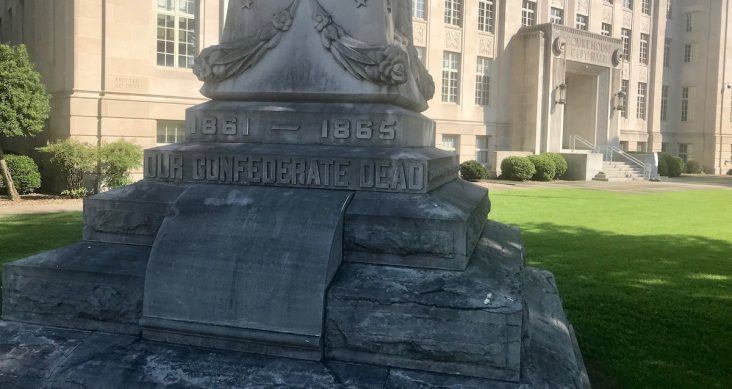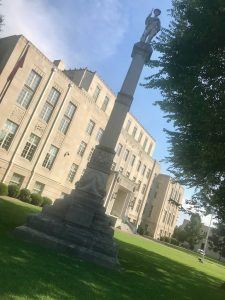No ‘organized or collaborative discussion’ about future of Confederate statue at Sebastian County courthouse
by June 3, 2020 6:58 pm 2,336 views

Part of the base of the Confederate monument on the grounds of the Sebastian County Courthouse.
A Confederate soldier statue on the Bentonville square is preparing for a move to a private park near the Bentonville Cemetery, but the Confederate monument on the grounds of the Sebastian County Courthouse looks like it is staying put.
According to an agreement announced June 1 between the Arkansas Division United Daughters of the Confederacy and the Benton County Historical Society the Bentonville statue will move to a park that will be named James H. Berry Park with the process beginning in August.
The controversial statue was placed on the Bentonville square in 1908 and was mistakenly considered by some as a statue of former Arkansas Gov. James Berry who took office in 1882. The statue is not of Berry, but is a common statue that is seen in many city squares and on courthouse lawns in the South. Berry helped pay for the statue, and a small plaque upon it in his honor following his death in 1913. Berry is buried in the Bentonville cemetery.
“The process to relocate the monument will begin in August after the UDC submits an application under the Arkansas Historic Preservation Program to maintain the monument on the National Registry of Historic Places,” noted a statement from Fort Smith attorney Joey McCutchen, who represented UDC. “After relocation, the Benton County Historical Society will own and operate the park and display the monument for the benefit of the residents of Benton County and the rich Civil War history of the Northwest Arkansas region. The UDC will continue to own the monument.”
Fort Smith also has a monument erected by the UDC. The Fort Smith Confederate Monument was erected in 1903 at the Sebastian County Courthouse in Fort Smith by the Varina Jefferson Davis Chapter of the UDC to commemorate local men who served in the Confederate army during the Civil War and to honor the Confederates buried in the U.S. National Cemetery in Fort Smith, where it was originally intended to be placed.

“Among several markers on the courthouse grounds is a statue of a Confederate soldier, on top of a pedestal nearly three stories tall that stands with its back toward a national cemetery a few blocks away from where it was originally planned to stand. The United States Secretary of War at the time refused to consent to the words ‘Lest we forget.’ The Confederate veterans and citizens who raised funds to erect the monument would not agree to the omission, and the statue was placed on the courthouse lawn,” according to information on the Arkansas Municipal League website.
The Encyclopedia of Arkansas noted this about rebuff from the Secretary of War: “When the federal government suggested a new design without those elements, a newspaper reported that ‘the condition imposed made the Daughters so indignant and so hurt them that they decided to find another site on which could be erected their magnificent tribute to the noble dead of the South.’” (Link here for more information about the Sebastian County statue.)
According to historic documents, Sebastian County supplied troops for both sides during the Civil War. Records indicate four infantry companies, a cavalry company and artillery battery joined the Arkansas State Troops in the early months of the year and at five infantry companies and two companies of independent scouts later joined the Confederates. Residents also enlisted in other Confederate units.
When the announcement was made about the Bentonville monument, McCutchen said the agreement can be a guide for “other communities to follow and also a model of peace, civility, and respect.” McCutchen, who was one of the Southside High School graduates who opposed changing the SHS mascot from the Rebels to the Mavericks in 2015. said he does not have nor know of any plans to move the Sebastian County monument. Sebastian County Judge David Hudson said he understands the planning process to move the Bentonville monument has been underway for the past three years and includes donated funding.
“That planning and coordination time frame provides perspective on the background for that project as it relates to other statutes in our state, including the one at the Sebastian County Courthouse,” Hudson said.
Hudson said he contacted McCutchen and Fort Smith Mayor George McGill concerning the statue and they know of no ongoing conversation to move the statue.
“It has been a number of years since this was a topic of conversation, and to my knowledge there is no organized or collaborative discussion like Bentonville,” Hudson said.
Mayor McGill told Talk Business & Politics he believes citizens will “muster the courage to do the right thing” with the statue. McGill, the first African-American mayor in the city’s history, said what happened in Bentonville does provide a good example, and Fort Smith and Sebastian County residents have to consider the image they want for their area.
“As we look at other cities across the nation, and as they begin to correct wrongs that happened in the past, they are removing these kinds of monuments. … We have an example of how these things can be handled with that (Bentonville statue). But we have to be mindful, you know, of the national image that we project. Are we going to be open to all families who come here to bring great businesses and great jobs? What does that say about us,” McGill said.
